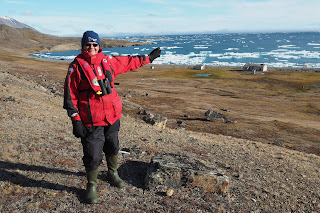 |
| Daybreak in Disko Bay |
We
awoke to the early morning light dancing on our porthole windows. Taking a look through our circular view on
the outside world, icebergs were the order of the day.
Climbing
the steep stairways to the upper decks we stood amazed at the unfolding
landscape which was bathed in a pink and orange glow. The reflections were spectacular as gentle
waves caught the morning light on sculpted chunks of glacial ice.
 |
| Early morning zodiac ride |
 |
| Humpacks breach amongst the icebergs |
We
had arrived in Disko Bay and the community of Ilulissat, Greenland. The Jacobshavn Icefjord, a UNESCO World
Heritage site, disgorges large icebergs out into Disko Bay. The glacier that produces these stunning
offspring is the most productive in the Northern Hemisphere, flowing at a rate
of about 100 feet a day and resulting in around 20 billion tons of ice passing out into the fjord every year.
Now and again the icebergs that break away from
the glacier are so large they are too tall to float down the fjord and lie
stuck on the ocean floor, sometimes for years, until they are eventually broken
up from the force of the glacier. It creates an unusual and surreal landscape.
A zodiac ride from Vavilov into the icefield was the highlight of the
morning. Icebergs bobbed in the water,
their shapes, geometric and irregular, some delicately etched like fine
crystal. We were surrounded! It was absolutely beautiful. Seabirds rested on these icy perches, their
high pitched screeching piercing the air.
The
icefield had created its own acoustics and it was as though we were in an
ancient cathedral. Occasionally there
would be a loud crack and then a tell tale whoosh as an iceberg calved, the
falling remnants of ice flooding the sea below and sending large ripples of
water outward.
 |
| Looking down over Jacobshavn Icefjord |
As
if this was not enough to amaze, a number of humpback whales surfaced, their
blowholes sending forceful bursts of water skyward. The humpbacks communicated with one another
as they arced and dove playfully, flashing a magnificent tail or two as they
disappeared below the surface.
On our journey to shore we witnessed another
unusual sight. A large iceberg was in
the process of calving and cracking loudly, and then it started to roll from
one side to the other. Our zodiac
leader instructed us to grab the rope line that encircled the craft and kneel
in its centre if the glacier split apart.
Luckily the danger passed.
Ilulissat’s
harbour is attractive, filled with colourful fishing boats and overlooked by
pretty wood framed houses high up on the cliffside. A
short bus ride out to the Jacobshavn Icefjord and a walk along a winding
boardwalk across the tundra took us to the head of the fjord and a spectacular
icefield that stretched as far as the eye could see. A lone arctic fox trotted across the ice
flow, likely in search of its next meal.
 |
| Who says you can't BBQ in the Arctic? |
Back
on board Vavilov we were treated to an outdoor barbeque with all the
fixings. Strains of Pink Floyd’s “Wish
you were here” played in the background.
How appropriate.
 |
Humpback swims in unison
with Vavilov |
 As
we wound down from a simply spectacular day in the Arctic there were several
more surprises in store. On the
starboard side of the Bow a humpback swam with the ship for a while, keeping
just below the surface.
As
we wound down from a simply spectacular day in the Arctic there were several
more surprises in store. On the
starboard side of the Bow a humpback swam with the ship for a while, keeping
just below the surface.
Looking down,
the massive creature’s body was clearly visible as it swam effortlessly with
Vavilov.
 |
| Wow, wow, wow! |

And then, as if we hadn't seen enough gorgeous icebergs that day, a massive piece of ice etched and sculpted with so many shapes and hollowed out arches appeared on the horizon. It glistened in the late afternoon sun, its base turquoise as waves lapped around the waterline.
As we approached, the Captain kindly navigated (carefully) around this piece of perfection so that we could view it on all sides. Occasionally there would be a loud crack and showers of ice cascaded in unison into the water.
And then silence returned to this mysterious Arctic world.
























































